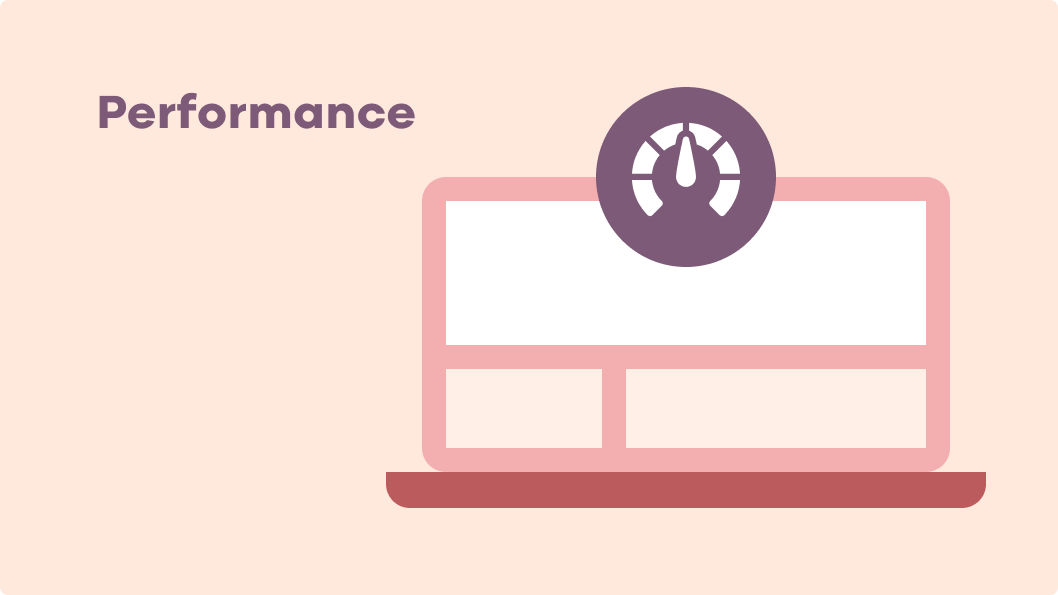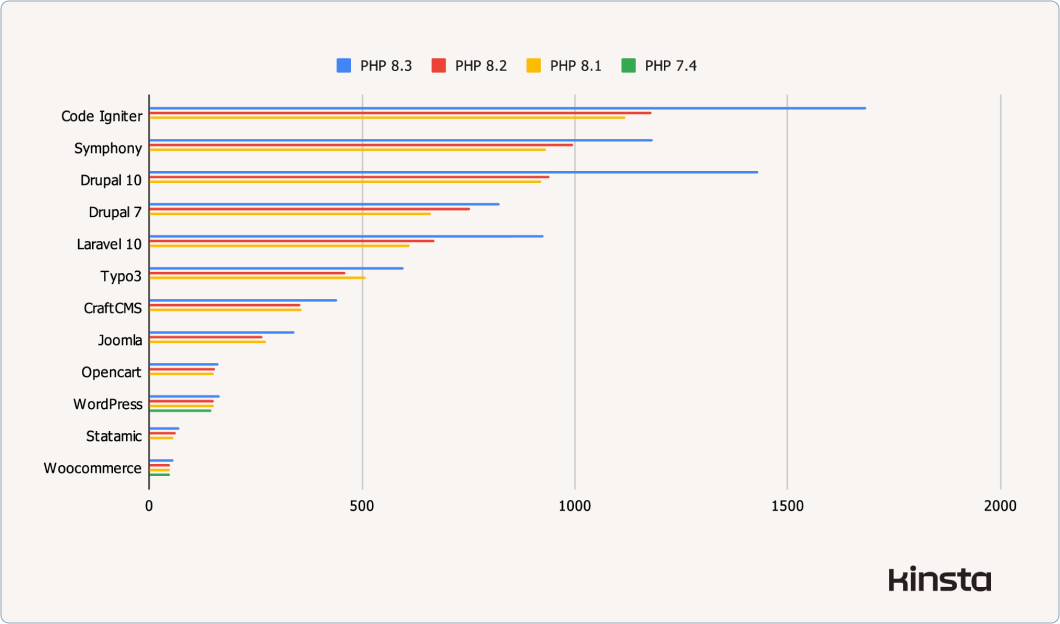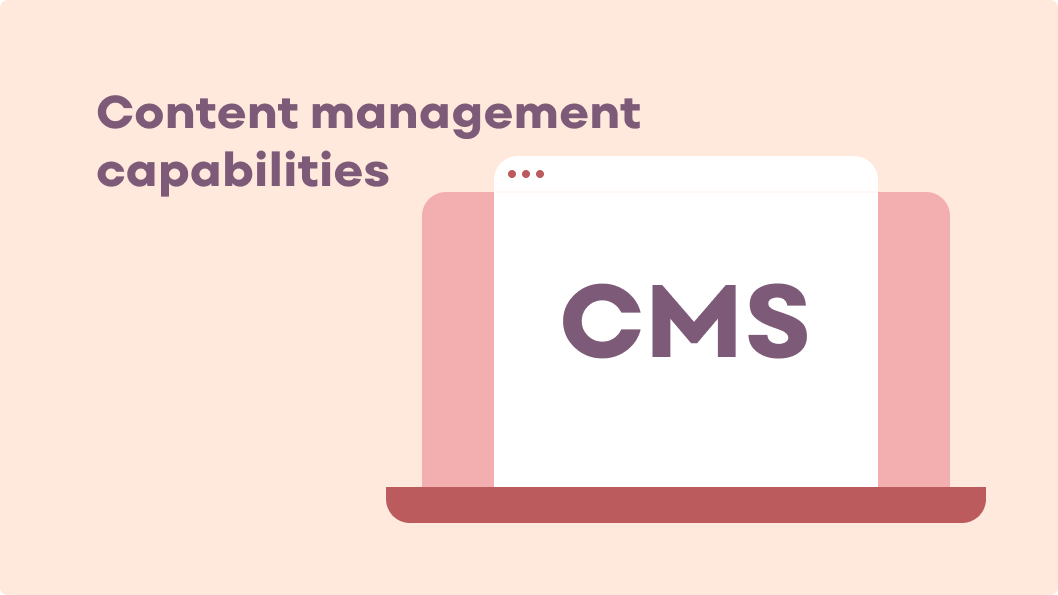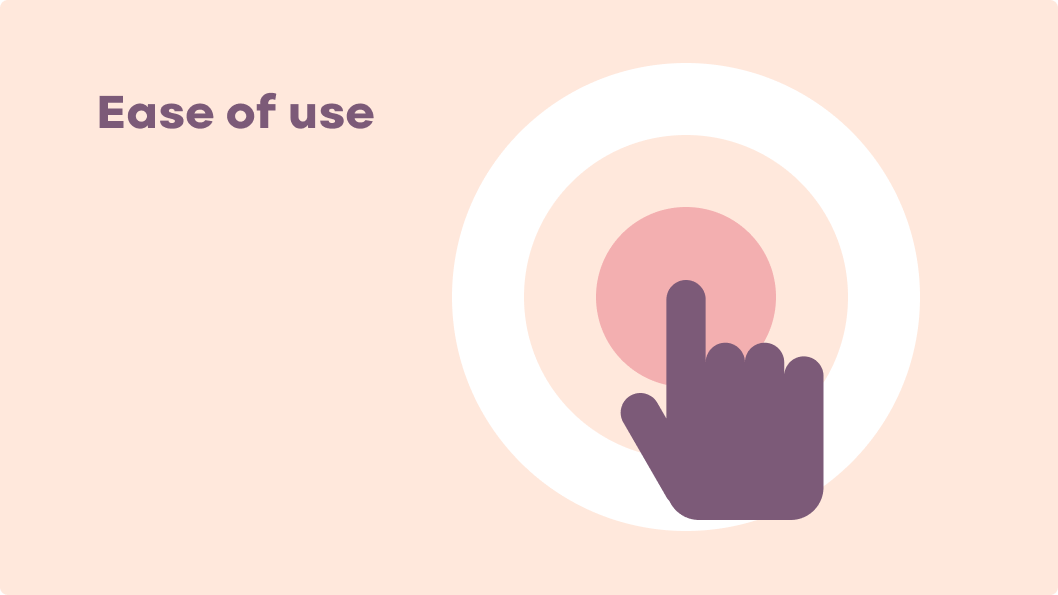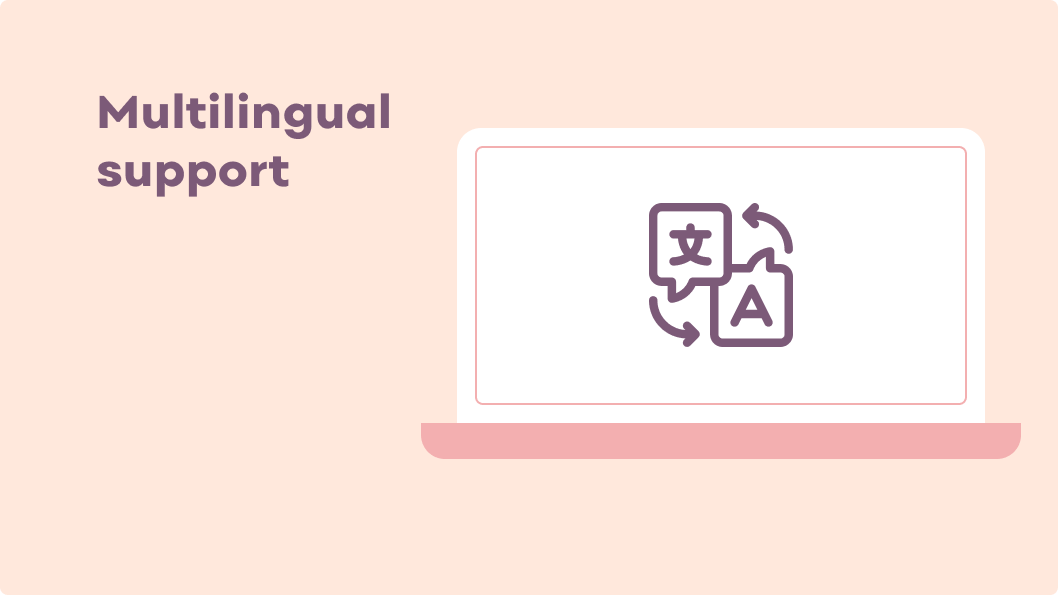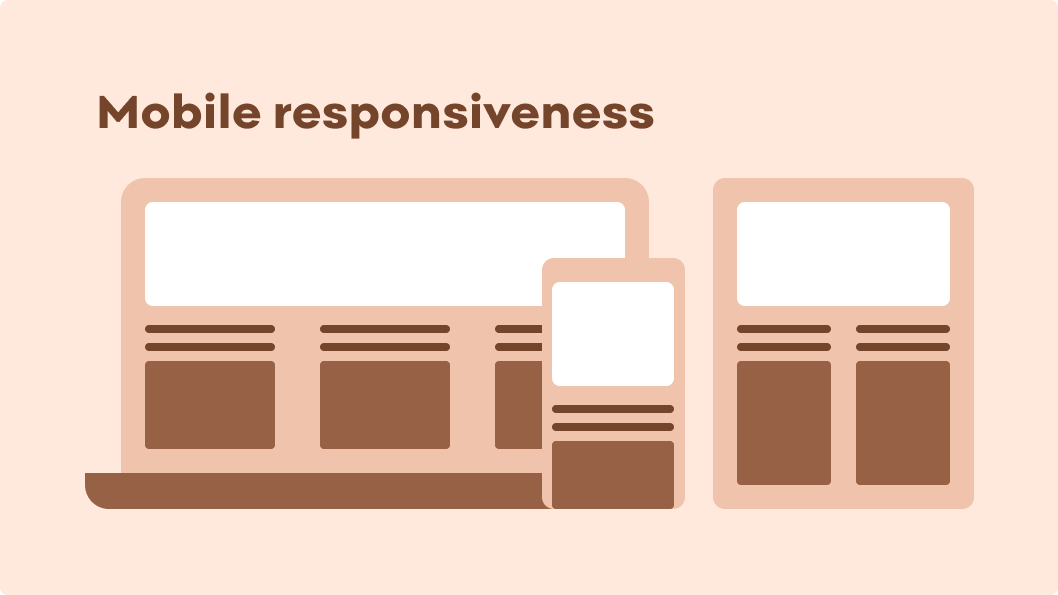
On this page:
- Quick decision guide: Drupal vs WordPress
- Bar chart comparison of WordPress vs Drupal
- The similarities between WordPress and Drupal
- The differences between WordPress and Drupal
- Critical differences between Drupal and WordPress
- WordPress example sites
- Drupal example sites
- Choosing the most suitable CMS based on specific website requirements
- Salsa Digital’s take
- Next steps
Quick decision guide: Drupal vs WordPress
Think of your website as a car and your choice of CMS as choosing the best car for your needs. If you’re sure your car will forever travel on a smooth road with a few bumps along the way, then should be your choice — it’s a simple, easy-to-use vehicle. However, if you envision that this road may lead you through many obstacles, maybe even crossing oceans, then should be your choice.
Enough of our car analogy. Let’s break down the content management systems.
When building or managing a website, there are a few key factors to consider. These are:
- Scalability
- Flexibility
- Performance
- Extendability
- Content management capabilities
- Documentation
- Ease of use
- Community support
- Security
- SEO friendliness
- Multilingual support
- Cost
- Mobile responsiveness
- Ecommerce capabilities
Below you’ll find a detailed analysis of both CMSs. To get personalised advice for your website, you may like to consider a site assessment. During this process, we can assess your existing site for the best CMS fit or assess your site requirements and recommend the best CMS.
Scalability
Scalability refers to a system's ability to handle growth and increased demands without compromising performance or functionality. In the context of CMSs like and , scalability is crucial for accommodating a growing number of users, content items and website traffic. A scalable platform should be capable of smoothly expanding to meet the evolving needs of a website, ensuring optimal performance and user experience even as the site's size and complexity increase.
Both WordPress and Drupal are scalable, but they may have different approaches to scalability.
| WordPress | Drupal |
|---|---|
| User-friendly and scalable with an extensive plugin ecosystem; scalability requires careful plugin and theme selection. | Provides advanced scalability and customisation for complex, enterprise-level websites but has a steeper learning curve. |
WordPress — Known for its ease of use and extensive plugin ecosystem, making it accessible to users of all levels. While it's highly scalable and suitable for a wide range of websites, its scalability can be influenced by the choice of themes and plugins. Some poorly coded or resource-intensive plugins might affect performance, so careful selection and optimisation are essential for large-scale projects.
Drupal — Often considered more inherently scalable for complex and enterprise-level websites. Drupal’s modular architecture and focus on flexibility allow developers to build highly customised and scalable solutions. Drupal's more complex learning curve can be an advantage in scenarios where advanced customisation and scalability are paramount.
Flexibility
Flexibility refers to the system's ability to adapt and accommodate diverse needs and requirements. A flexible platform allows users to customise and tailor the website's design, structure and functionality to suit their specific goals. It empowers users to make changes, add features and create unique content layouts without being constrained by rigid templates or predefined structures. This provides a versatile foundation for a wide range of websites and applications.
| WordPress | Drupal |
|---|---|
| Has an easy-to-use interface with a vast ecosystem of themes and plugins for easy customisation, suitable for users at any technical skill level. | Excels in flexibility for complex, highly customised projects, and its modular architecture is ideal for enterprise-level websites. |
WordPress — A user-friendly interface and a vast ecosystem of themes and plugins that provide a high degree of customisation. Users, even those without advanced technical skills, can easily modify the appearance and functionality of their WordPress websites by choosing the right combination of plugins.
Drupal — Often regarded as more flexible in handling complex and highly customised projects. Its modular architecture and emphasis on flexibility make it a preferred choice for developers working on enterprise-level websites or applications with intricate requirements.
Performance
Performance refers to how efficiently and quickly a website operates. It encompasses factors like page load times, server response times and overall responsiveness. A high-performing CMS ensures that web pages load quickly, providing a seamless user experience even under heavy traffic loads. Optimising performance is crucial for retaining visitors, improving search engine rankings, and achieving business objectives such as conversions and engagement.
and can both achieve excellent performance, but performance comparisons between them can be nuanced and dependent on various factors.
| WordPress | Drupal |
|---|---|
| Achieves high performance through caching plugins, CDNs, server optimisations, and themes and plugins that enhance website speed. | Delivers superior performance for complex websites with its robust architecture, smart caching mechanisms, and efficient handling of heavy traffic loads. |
WordPress — Can achieve high performance for many types of websites with its widespread usage and extensive optimisation options through caching plugins, content delivery networks (CDNs) and server-side optimisations. Additionally, WordPress benefits from its large ecosystem of themes and plugins, with many specifically designed to enhance performance.
Drupal — Offers drastically better performance out-of-the-box for complex and highly customised websites with its more robust and structured architecture. Its smart caching mechanisms, such as the built-in caching layer and integration with external caching solutions, contribute to its ability to handle heavy traffic loads extremely efficiently.
The folks at Kinsta have done an excellent PHP benchmark speed test across different .
All things equal, far outperformed .
Extendability
Extendability refers to expanding and enhancing the platform's functionality beyond its core features. A highly extendable CMS allows users to seamlessly integrate additional modules, plugins or extensions to meet specific requirements or add new features. This flexibility empowers website owners and developers to customise their websites extensively without needing to modify the core codebase, enabling scalability and adaptability to evolving needs and technological advancements.
| WordPress | Drupal |
|---|---|
| Allows easy addition of features and integrations with a wide range of plugins and themes, even without deep technical knowledge. | Its modular architecture supports extensive customisation through custom modules. |
WordPress — Renowned for its extendability, thanks to its extensive ecosystem of plugins and themes. The WordPress Plugin offers a vast array of free and premium plugins that cater to a wide range of functionalities. These plugins enable users to add features, enhance performance and integrate with third-party services without needing advanced coding skills. The WordPress theme system also contributes to its extendability, allowing users to easily change their websites' look and feel. WordPress often stands out for its user-friendly plugin ecosystem, making it accessible to a broader audience for extending functionality without deep technical expertise.
Drupal — While also highly extendable, Drupal takes a different approach. Its modular allows developers to create custom modules to extend functionality. Drupal's emphasis on structured data and a more complex learning curve makes it particularly suitable for intricate projects requiring a high level of customisation.
Content management capabilities
Content management capabilities refer to a content management system's ability to efficiently create, organise, edit and publish digital content. This includes features such as a user-friendly interface for content editors, support for various content types (text, images, videos), version control, workflow management, and the ability to organise content hierarchically. A robust content management system empowers users to manage and present their information effectively, ensuring a seamless and organised digital experience for both content creators and website visitors.
| WordPress | Drupal |
|---|---|
| Offers an intuitive UI and WYSIWYG editor that simplifies content creation and management. | Provides a structured and modular content management system that is perfect for complex projects. |
WordPress — Renowned for its intuitive user interface, enabling content editors, including those with minimal technical expertise, to efficiently create and manage content. Its user-friendly WYSIWYG editor simplifies tasks such as adding and formatting text, images, and multimedia. WordPress's streamlined post and page management system, complemented by categories and tags, facilitates easy organisation of content. Moreover, the extensive plugin ecosystem, which includes popular tools such as WP Elementor, WP Bakery, and Beaver Builder, offers additional options to enhance content management, ranging from SEO optimisation tools to editorial calendars.
Drupal — Its more structured and modular approach provides powerful content management capabilities suitable for complex and highly customised projects. It allows for the creation of custom content types, offering a high level of flexibility in organising and presenting information. Drupal's taxonomy system enables the categorisation of content, and its robust permission and workflow management make it suitable for collaborative content creation in enterprise environments. Drupal, with its more intricate system, excels in scenarios where advanced content structuring and customisation are critical. Additionally, Drupal comes with CK Editor, a built-in WYSIWYG editor.
Documentation
Documentation refers to the comprehensive and organised information provided by the CMS to guide users, developers and administrators on how to use, configure and troubleshoot the system. Good documentation includes clear instructions, examples and explanations of features, settings and functionalities, helping users understand and navigate the software effectively. It serves as a valuable resource for both beginners and experienced users, fostering a smoother learning curve and facilitating the successful implementation and maintenance of the software.
| WordPress | Drupal |
|---|---|
| Has accessible and user-friendly documentation for users of all levels. | Has robust documentation but is tailored towards developers and technical users. |
WordPress — Documentation is known for its accessibility and user-friendly nature, catering to users of all skill levels. The official WordPress serves as a comprehensive resource covering topics ranging from basic setup and usage to more advanced customisation and development. Additionally, provides tutorials, forums and user guides, offering multiple avenues for finding answers to questions and troubleshooting issues.
Drupal — Drupal's is also robust, but due to its complexity and emphasis on customisation, it may be perceived as more geared towards developers and technical users. The Drupal.org includes guides, tutorials and API references covering various aspects of site building, theming, module development and system administration. While comprehensive, Drupal's documentation may have a steeper learning curve for beginners compared to WordPress.
Apart from the documentation provided on and , there is lots of free user-contributed documentation available on other platforms such as YouTube and LinkedIn.
Ease of use
Ease of use refers to how intuitive and user-friendly a software or platform is for its intended users. In the context of content management systems (CMSs), ease of use encompasses factors such as the simplicity of the user interface, the intuitiveness of navigation and the clarity of instructions. A CMS with high ease of use enables users, including content editors and administrators, to accomplish tasks efficiently without requiring extensive training or technical expertise. It minimises complexity and barriers to entry, fostering a positive user experience and increasing productivity.
| WordPress | Drupal |
|---|---|
| Has an intuitive, drag-and-drop, user-friendly interface accessible to users of all skill levels. | Has a complex interface that focuses on customisation and requires more time to master. |
WordPress — Widely recognised for its ease of use, offering a user-friendly interface that makes it accessible to users of all skill levels. Its intuitive dashboard and straightforward content management system allow users to create, edit and publish content with ease. The interface is designed to be intuitive, with features such as drag-and-drop functionality and visual editors, enabling users to customise their websites without needing extensive technical knowledge. Additionally, WordPress benefits from a vast ecosystem of themes and plugins that further simplify the website-building process.
Drupal — While powerful and flexible, Drupal has a steeper learning curve compared to WordPress. Its interface is more complex, reflecting its focus on customisation and scalability for enterprise-level projects. Drupal's modular architecture allows for extensive customisation, but it may require more time and effort for users to become familiar with its advanced features and terminology. However, Drupal's emphasis on structured content and granular permissions makes it well-suited for complex websites and applications requiring sophisticated content management capabilities.
Community support
Community support refers to the collective assistance, resources and collaboration provided by users, developers and enthusiasts of a particular software or platform. It encompasses online forums, discussion groups, documentation, tutorials and user groups dedicated to helping users troubleshoot issues, share knowledge and collaborate on development projects. A strong community support network fosters learning, problem-solving, and innovation, enhancing the overall user experience and contributing to the growth and improvement of the CMS ecosystem.
| WordPress | Drupal |
|---|---|
| Boasts one of the largest CMS communities with extensive support resources that are available to all users, from beginning to expert. | Has a smaller but highly technical collaborative community that offers robust support for advanced users. |
WordPress — With millions of users worldwide, WordPress has a vast ecosystem of forums, online communities and user groups dedicated to providing support, sharing knowledge and collaborating on projects. The WordPress community is known for its accessibility and inclusivity, welcoming users of all skill levels and backgrounds. Additionally, the WordPress.org hosts extensive documentation, tutorials and user guides, further enhancing the support available to users.
Drupal — Drupal's community is known for its technical expertise and dedication to open-source principles. Users can find support through Drupal.org , issues , Slack channels and local user groups. The Drupal community is highly active in contributing modules, themes and documentation, reflecting a strong culture of collaboration and contribution. However, Drupal's community may have a steeper learning curve for beginners due to its emphasis on technical topics and advanced customisation.
Security
Security refers to the measures and practices implemented to protect a system, network or software application from unauthorised access, data breaches and malicious activities. It encompasses features such as user authentication, data encryption, access controls, vulnerability monitoring, two-factor authentication and regular software updates. A secure CMS helps safeguard sensitive information, prevent unauthorised modifications or deletions and mitigate the risks associated with cyber threats, ensuring the integrity, confidentiality and availability of the website or application.
| WordPress | Drupal |
|---|---|
| Boasts one of the largest CMS communities with extensive support resources that are available to all users, from beginning to expert. | Has a smaller but highly technical collaborative community that offers robust support for advanced users. |
WordPress — Has historically been a target for security attacks due to its widespread usage and popularity. However, the core team and the broader community are highly vigilant about security vulnerabilities. WordPress regularly releases updates and security patches to address known vulnerabilities, and the platform has a robust ecosystem of security plugins and services that can further enhance website security. Additionally, WordPress emphasises best security practices such as strong passwords, user permissions and regular backups to help users protect their websites.
Drupal — Often perceived as more inherently secure than WordPress due to its more structured and stringent security model. Drupal's core architecture is designed with security in mind, and its development process includes rigorous code reviews and security audits. Drupal's dedicated security actively monitors and responds to security threats, releasing timely security advisories and patches. Furthermore, Drupal's permission system offers fine-grained control over user access, reducing the risk of unauthorised modifications or data breaches.
SEO friendliness
SEO friendliness refers to a content management system's ability to support and facilitate search engine optimisation (SEO) efforts. This includes features such as customisable URLs, meta tags, sitemaps and responsive design, which help improve a website's visibility and ranking in search engine results pages (SERPs). A CMS with strong SEO capabilities provides users with the tools and functionalities needed to optimise their content for search engines, ultimately driving organic traffic and enhancing the website's online presence and performance.
| WordPress | Drupal |
|---|---|
| Has a strong SEO-friendly foundation with easy-to-use plugins, customisable permalinks and responsive design that’s accessible to all users. | Offers advanced SEO capabilities through special modules but requires more technical expertise. |
WordPress — Has a reputation for being SEO-friendly, thanks in part to its extensive ecosystem of plugins like Yoast and All in One SEO , which offer powerful tools for optimising content, meta tags, XML sitemaps, and more. WordPress also provides features like clean permalinks, customisable title tags and responsive themes, all of which contribute to its SEO-friendliness. Additionally, WordPress has a large community and plenty of resources available to help users understand and implement SEO best practices effectively.
Drupal — While also capable of supporting SEO efforts, may require more technical expertise to fully leverage its SEO capabilities. Drupal's structured data and granular control over content and URLs can be advantageous for SEO, but it may be less intuitive for beginners to implement compared to WordPress. Drupal modules like and can enhance SEO functionality, but users may need to invest more time in configuration and customisation.
Multilingual support
Multilingual support refers to a content management system's ability to handle content in multiple languages, allowing users to create, manage and display content in different languages on the same website. This includes features such as language detection, translation management, multilingual content editing interfaces and URL handling for different language versions. A CMS with robust multilingual support enables websites to reach a global audience, cater to diverse language preferences and provide a seamless experience for users regardless of their language.
| WordPress | Drupal |
|---|---|
| Provides basic multilingual support through plugins but requires additional configuration for advanced translation. | Offers robust native multilingual capabilities that allow for granular language management. |
WordPress — Basic multilingual support out-of-the-box, allowing users to create multilingual websites using plugins such as WPML (WordPress Multilingual) and . These plugins enable users to translate content, manage language-specific versions of pages and posts, and create language switchers for visitors. While WordPress's multilingual support is functional, it may require additional plugins and configurations for more advanced features, such as automatic translation and multilingual SEO.
Drupal — Offers more robust native multilingual capabilities. Drupal's core architecture includes built-in support for multilingual websites, allowing users to create language-specific versions of content types, taxonomies and menus. Drupal's language handling features are more granular, with options for content translation, interface translation and language detection. Additionally, Drupal's multilingual modules offer advanced features such as language fallbacks, translation workflows and multilingual SEO optimisation.
Cost
Cost refers to the total expenditure associated with implementing, maintaining and operating a content management system (CMS). This includes expenses such as initial setup costs, licensing fees (if applicable), hosting fees, ongoing maintenance and support, customisation and development costs, and any additional expenses related to plugins, themes, or integrations.
Evaluating the cost of a CMS involves considering both upfront and long-term expenses to determine the most cost-effective solution for the organisation's budget and requirements.
| WordPress | Drupal |
|---|---|
| Low initial setup costs as it’s free to download and use. Premium themes and plugins cost more. | Higher initial setup costs, especially for complex projects, though most modules and costs are free. |
| Has a vast selection of both free and premium plugins and themes. | Has a small selection of themes and modules, but most contributed themes and modules are free. |
| Has an active community and extensive documentation available with many first and third-party support options, both free and paid. | Has a strong community and support documentation, but support and maintenance costs might rise due to the complexity. |
| Both can be hosted on various platforms, with costs varying by server specifications, performance and support. | |
| Costs vary based on the project complexity and developer expertise but might be higher due to Drupal’s complexity. | |
Initial setup costs:
WordPress: The initial setup costs can be relatively low, especially if using a shared hosting provider. WordPress itself is free to download and use, but there will be costs associated with premium themes, plugins and professional services for customisation or setup.
Drupal: The initial setup costs for Drupal can be higher compared to WordPress, especially for complex projects. While Drupal core is free, there may be additional costs for hosting, premium themes and development services. However, most Drupal-contributed modules and themes are free.
Themes and plugins:
WordPress: WordPress offers a vast selection of free and premium themes and plugins, which can vary in cost. While there are many free options available, premium themes and plugins will incur additional costs.
Drupal: Drupal also offers themes and modules, but the selection may be smaller compared to WordPress. Drupal’s contributed themes and modules are free.
Customisation and development:
- Both WordPress and Drupal may require customisation or development work to meet specific requirements. Costs for customisation and development services can vary depending on the complexity of the project and the expertise of the developers.
Hosting costs:
- Both WordPress and Drupal can be hosted on a variety of platforms, ranging from shared hosting to dedicated servers. Hosting costs can vary depending on factors such as server specifications, performance and support.
Support and maintenance:
WordPress: WordPress has a large community and extensive documentation, which can be valuable resources for support. Additionally, there are many third-party support options available, ranging from forums to paid support services.
Drupal: Drupal also has a strong community and documentation, along with third-party support options. However, due to its more complex nature, support and maintenance costs may be higher compared to WordPress in most cases.
Mobile responsiveness
Mobile responsiveness refers to a website's ability to adapt and display content properly on various devices with different screen sizes and resolutions, including smartphones, tablets and desktop computers. A mobile-responsive website dynamically adjusts its layout, content and design elements to ensure optimal viewing and usability across different devices and screen orientations. This enhances the user experience, improves accessibility and contributes to better search engine rankings, as search engines prioritise mobile-friendly websites in their search results.
| WordPress | Drupal |
|---|---|
| Offers a wide selection of mobile-responsive themes and plugins to enhance mobile responsiveness. | Provides a limited selection of mobile-responsive themes and modules with options for customisation. |
WordPress —WordPress is known for its extensive selection of mobile-responsive themes. Many free and premium themes available for WordPress are built with mobile responsiveness in mind, ensuring that websites automatically adapt to different screen sizes and devices.
Additionally, WordPress has a large ecosystem of plugins that can further enhance mobile responsiveness. Plugins like provide mobile-specific features and optimisations to improve the user experience on smartphones and tablets.
Drupal — Drupal also offers mobile-responsive themes and modules, but the selection may be more limited compared to WordPress. However, many popular Drupal themes and modules are designed with mobile responsiveness in mind, ensuring that websites remain functional and visually appealing on mobile devices.
Drupal's flexibility and customisation options allow developers to create highly customised and mobile-responsive website themes tailored to specific requirements.
Ecommerce capabilities
Ecommerce capabilities refer to a content management system's ability to support online selling and transactional activities. This includes features such as product listings, shopping cart functionality, secure payment processing, order management and inventory tracking. A CMS with robust e-commerce capabilities enables businesses to create and manage online stores, sell products or services, process payments securely and provide a seamless shopping experience for customers.
| WordPress | Drupal |
|---|---|
| Excels in ecommerce through plugins like WooCommerce that offer a comprehensive, easy-to-use and lightly customisable solution for online stores. | Provides robust and sophisticated ecommerce solutions with Drupal Commerce and Ubercart, which are very flexible and customisable but have a steep learning curve. |
WordPress — WordPress is well-known for its e-commerce capabilities, primarily through the WooCommerce . WooCommerce is one of the most popular e-commerce platforms globally, offering a comprehensive set of features for creating and managing online stores. It allows users to sell physical and digital products, manage inventory, set up shipping options and process payments securely.
In addition to WooCommerce, WordPress also offers other e-commerce plugins, such as Easy Digital and WP , providing users with options to suit their specific needs and preferences.
WordPress's extensive plugin ecosystem and user-friendly interface make it easy for users to set up and customise their online stores without extensive technical expertise.
Drupal —Drupal offers e-commerce capabilities through modules such as Drupal and .
Drupal is a flexible and customisable ecommerce framework that allows users to build sophisticated online stores tailored to specific requirements. It provides features for product management, order management, payment processing and integration with other Drupal modules.
is another ecommerce module for Drupal, offering a more straightforward approach to setting up online stores with features such as product listings, shopping cart functionality and payment processing.
While Drupal's ecommerce modules offer powerful capabilities, they may require more technical expertise and development effort compared to WordPress. Drupal's focus on flexibility and customisation makes it suitable for complex ecommerce projects but may have a steeper learning curve for beginners.
Bar chart comparison of WordPress vs Drupal
Below is a bar chart illustrating the comparative strengths of the various aspects of both CMSs. The scores on this scale are hypothetical and not based on mathematical calculations. Rather, they offer a qualitative assessment to help users understand the relative positions of both CMS platforms when evaluated side-by-side.
On the Y axis, it starts from 0 to 100 with 100 being the best.
On the X axis, we have labelled each aspect and displayed where WordPress and Drupal fall compared with each other.
The similarities between WordPress and Drupal
Despite their differences, Drupal and WordPress share several similarities:
Open source: Both Drupal and WordPress are open source content management systems, meaning their source code is freely available for anyone to use, modify and distribute. This has created a collaborative community of developers, contributors and users who work together to improve the platforms.
Content management: Drupal and WordPress excel in content management capabilities, offering intuitive interfaces for creating, editing and organising content. They support various content types, including text, images, videos, and more, making them suitable for a wide range of websites and applications.
Customisation: Drupal and WordPress are highly customisable, allowing users to extend and modify their functionality to suit specific requirements. They offer extensive theme and plugin/module ecosystems, enabling users to easily customise their websites' design, features and functionality.
Community support: Both Drupal and WordPress have vibrant and active communities of users, developers and enthusiasts who provide support, share knowledge and contribute to the platforms' growth and improvement. Community support forums, documentation and resources are available to help users troubleshoot issues, learn new techniques and collaborate on projects.
Scalability: Drupal and WordPress are scalable platforms capable of handling websites of all sizes, from small blogs to large enterprise-level applications. They can accommodate growing content, traffic and functionality requirements, making them versatile solutions for diverse projects.
SEO-friendliness: Both Drupal and WordPress offer features and capabilities to support search engine optimisation (SEO) efforts, including customisable URLs, meta tags, sitemaps and responsive design. They prioritise SEO best practices to help improve website visibility and rankings in search engine results pages (SERPs).
Architecture: Drupal and WordPress are typically deployed on the LAMP stack, which stands for Linux, Apache, MySQL, and PHP. Both Drupal and WordPress have similar server requirements, including PHP and MySQL versions and dependencies such as Apache or Nginx web servers. They are compatible with most standard web hosting environments that support the LAMP stack.
Both Drupal and WordPress have a modular architecture, which allows developers to extend and customise their functionality through themes, plugins and modules.
The differences between WordPress and Drupal
Below are some key differences between WordPress and Drupal.
WordPress: Primarily targets bloggers, small businesses, and individuals who prioritise ease of use and simplicity. It's known for its user-friendly interface and extensive plugin ecosystem, making it accessible to users of all skill levels.
Drupal: Targets developers, enterprises and organisations with complex requirements. It offers a highly flexible and customisable framework suitable for building large-scale websites, web applications and intranets.
Flexibility and customisation
WordPress: Offers a wide range of themes and plugins that enable users to customise their websites easily. While WordPress is flexible, its customisation options may be more limited compared to Drupal, particularly for complex or highly customised projects.
Drupal: Provides extensive flexibility and customisation options, allowing developers to create highly customised and intricate websites. Drupal's modular architecture and emphasis on flexibility make it suitable for projects with specific requirements, such as ecommerce platforms, social networking sites and government portals.
Complexity
WordPress: Generally considered more straightforward and less complex than Drupal. Its user-friendly interface and intuitive content management system make it easier for beginners to get started.
Drupal: Has a steeper learning curve due to its complexity and advanced features. Drupal's architecture and terminology may be more challenging for beginners, requiring a higher level of technical expertise to master.
Community and support
WordPress: Has a larger and more diverse community compared to Drupal, with extensive documentation, forums, and resources available to users of all levels. The large community contributes to WordPress's popularity and accessibility.
Drupal: While Drupal has a strong and dedicated community, it may be smaller and more focused on technical topics compared to WordPress. Drupal's community provides comprehensive support and resources but may require more technical knowledge to fully leverage.
Use cases
WordPress: Well-suited for blogs, small business websites, personal portfolios and simple ecommerce sites. It excels in scenarios where ease of use and quick setup are priorities.
Drupal: Ideal for complex and large-scale projects such as enterprise websites, government portals, social networking platforms and intranets. Drupal's flexibility and scalability make it suitable for projects with intricate requirements and high traffic volumes.
Assumptions
WordPress: Makes a lot of assumptions about what you are trying to achieve. It’s typically geared towards blogging-type sites. If you stray from this, some heavy customisations will be needed to achieve the beyond.
Drupal: Does not make any assumptions about your website. It’s built with a solid foundation that you then build on to customise exactly to your needs.
Caching
WordPress: WordPress caching solutions often rely on plugins that provide caching functionality. WordPress caching plugins typically offer user-friendly interfaces and configuration options, making it easy for users to enable caching without extensive technical knowledge.
Drupal: Drupal offers built-in caching mechanisms as part of its core functionality. It includes caching layers for page caching, block caching and dynamic page caching. Drupal provides fine-grained control over caching settings through its administrative interface, allowing administrators to configure caching policies based on specific criteria such as content types, user roles and URL patterns. Drupal’s “smart” caching system is arguably far more advanced than WordPress. With minimal configuration, Drupal is far more optimised for caching than WordPress out-of-the-box.
Critical differences between Drupal and WordPress
In the above section, we identified common differences between WordPress and Drupal. In this section, we elaborate on the critical differences that really separate the two.
Content types
WordPress comes with page and post content types out-of-the-box. If you need more content types, you can add fields to these content types, thereby repurposing the Page content type (or using paid third-party plugins to build more content types).
Drupal comes with an article and basic page content type out-of-the-box. Adding more content types is simple and can be done right within the UI without adding any additional Drupal modules. Drupal's more structured approach to content types makes the storing and caching of content extremely more efficient and performant.
Assumptions
WordPress tends to make some assumptions about your website, but it is not going to be streamlined for every scenario. If your site does not follow that pattern, you’ll find yourself wrangling with WordPress to customise it in different ways.
Drupal does not make any assumptions about your site. Therefore, it provides a solid base with some default generic settings and customisations that you can then extend in any direction as needed. This approach will fit any scenario.
Plugins and modules
WordPress has a massive library of Plugins. Plugins are what provide additional functionality to your WordPress site. All of these external plugins do very specific things on their own. However, getting them to interact with each other can be problematic.
Drupal also has a massive library of modules. Modules are the equivalent of plugins in WordPress. Due to the way Drupal is built, these modules can interact with each other, thereby allowing more flexibility.
Costs
WordPress plugins are typically free and come with paid premium options. As your site grows, your costs will also grow to keep abreast of these premium plugins.
Drupal’s modules are free to use, and there are no premium options (except in a few rare cases).
Security
WordPress plugins are written and maintained by external vendors. There are no strict security or code quality control measures. Therefore, your site is as strong as the weakest plugin.
Drupal modules have strict security compliance testing built in. Modules that have adopted the Drupal security policy are clearly marked, and security patches are broadcasted in a timely manner.
Caching
WordPress has built-in caching that can also be extended by plugins.
Drupal is far superior in terms of performance and caching out-of-the-box. Its caching system is “smart” and recognised as one of the best in the industry.
Ease of use
WordPress is easy to use and set up. You can have a simple site up and running within just a few days.
Drupal definitely has a steeper learning curve and is more geared towards developers. It will take a longer time to set up and implement.
WordPress example sites
Popular websites like Time , and Harvard rely on WordPress for customisation. These sites demonstrate WordPress's ability to create visually appealing designs, unique layouts and personalised features using its wide range of themes and plugins.
Drupal example sites
High-trafficked and enterprise-level sites such as , the Australian , , the Emmy , and the Government of Canada are just a few examples of high-profile websites built on Drupal. These websites exhibit complex design elements, advanced functionality and customised features, highlighting Drupal's unparalleled customisation capabilities.
Choosing the most suitable CMS based on specific website requirements
When choosing the best CMS for you, consider the following factors:
- The complexity and size of your website
- Your level of technical expertise
- The desired level of customisation
- Your preference for user-friendly interfaces
- Your need for specific functionalities or plugins
- Your budget and timeframe
By evaluating these factors, you can decide whether Drupal or WordPress is the most suitable CMS for your website.
Salsa Digital can provide expert technical support and assessments to help you find out the best CMS for you.
Salsa Digital’s take
The comparison between WordPress and Drupal reveals distinctive strengths and considerations that cater to different user needs and project requirements.
WordPress stands out for its user-friendly interface, extensive plugin ecosystem and accessibility, making it an ideal choice for smaller-scale projects and users seeking simplicity. On the other hand, Drupal offers unparalleled flexibility, scalability and customisation options, making it well-suited for complex, enterprise-level projects and developers with specific technical requirements.
Both CMS platforms excel in different areas, and, the choice between them ultimately depends on factors such as project scope, technical expertise and desired features.
By understanding the unique attributes of each platform, users can make informed decisions to select the CMS that best aligns with their goals and objectives.
Next steps
To further explore and understand the capabilities of Drupal and WordPress, consider the following steps:
Research case studies and success stories of websites built with Drupal and WordPress
Read in-depth comparisons and reviews of Drupal and WordPress
Visit the official websites of Drupal and WordPress to explore their documentation and resources
Consult with developers or professionals experienced in working with Drupal and WordPress
Consider setting up a test environment to experiment with both CMSs and evaluate their features and functionalities
Remember, the choice between Drupal and WordPress ultimately depends on your specific website requirements, technical expertise and budget. Take the time to thoroughly assess these factors before deciding, and you will be on your way to building a successful website. Alternatively, employ a digital agency like Salsa to review your requirements and recommend the best option for you.



